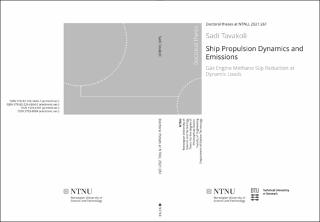| dc.contributor.advisor | Pedersen, Eilif | |
| dc.contributor.advisor | Schramm, Jesper | |
| dc.contributor.author | Tavakoli, Sadi | |
| dc.date.accessioned | 2021-09-23T08:32:42Z | |
| dc.date.available | 2021-09-23T08:32:42Z | |
| dc.date.issued | 2021 | |
| dc.identifier.isbn | 978-82-326-6664-5 | |
| dc.identifier.issn | 2703-8084 | |
| dc.identifier.uri | https://hdl.handle.net/11250/2780697 | |
| dc.description.abstract | Continuous discharging of greenhouse gases into the atmosphere has motivated researchers to develop prime movers for working with less polluted energy sources. The low cost of natural gas relative to diesel and gasoline combined with various emissions-related regulatory measures drew attention toward natural gas as an alternative fuel for internal combustion engines.
Natural gas fuel utilization is regarded as the right choice due to its low-carbon emission, lower NOX, and almost zero smoke and particulate matter. Among several categorizations of the natural gas engine, including stoichiometric Otto cycle, lean burn, and dual fuel, there is a particular interest in lean burn gas engines where the excess air ratio is almost two, and the emission target is achievable without applying an after-treatment system.
However, there are also several challenges with lean combustion. The knock phenomenon limits the engine performance in high loads and rich mixture, and in contrast, misfires occur when the mixture is too lean. Working in a narrow operating area with high-efficiency combustion requires sufficient stability and control of the engine.
For an engine encountering a time-varying load in a marine application, load on the engine continuously varies in either a fixed or a variable frequency. Depending on the magnitude of load fluctuation, the response of the engine changes. Moreover, despite the low emission level provided by a lean burn natural gas engine, the lean mixture combustion suffers from high methane slip.
This study developed a model for a spark-ignition engine that uses natural gas as the fuel and is applicable for the marine sector. The work in this thesis investigates the effect of sea state on ship propulsion systems.
Accordingly, the thesis consists of four major parts. First, the influence of time-varying load on the lean burn gas engine is discussed, and the response of the engine and the importance of methane slip sources are presented. Second, engine-propeller interaction has been studied in a range of wave characteristics, and the engine response has been discussed in all sea states for the specific vessel. Third, considering methane slip as the main issue of lean burn gas engines, several controlling methods have been performed to overcome the methane slip increase during transient conditions. Furthermore, the part-load operation of the engine has been modeled by a non-harmonic transient condition in almost one hour of the vessel journey. | |
| dc.language.iso | eng | en_US |
| dc.publisher | NTNU | en_US |
| dc.relation.ispartofseries | Doctoral theses at NTNU;2021:261 | |
| dc.relation.haspart | Paper 1: Tavakoli, Sadi; Vincent Jensen, Michael; Pedersen, Eilif; Schramm, Jesper. Unburned Hydrocarbon Formation in a Natural Gas Engine Under Sea Wave Load Conditions. Journal of Marine Science and Technology 2021 ;Volum 26. s. 128-140 https://doi.org/10.1007/s00773-020-00726-5 This article is published under an open access license | en_US |
| dc.relation.haspart | Paper 2: Saettone, Simone; Tavakoli, Sadi; Taskar, Bhushan; Vincent Jensen, Michael; Pedersen, Eilif; Schramm, Jesper; Steen, Sverre; Andersen, Poul. The importance of the engine-propeller model accuracy on the performance prediction of a marine propulsion system in the presence of waves. Applied Ocean Research 2020 ;Volum 103 https://doi.org/10.1016/j.apor.2020.102320 | en_US |
| dc.relation.haspart | Paper 3: Tavakoli, Sadi; Saettone, Simone; Steen, Sverre; Andersen, Poul; Schramm, Jesper; Pedersen, Eilif. Modeling and analysis of performance and emissions of marine lean-burn natural gas engine propulsion in waves. Applied Energy 2020 ;Volum 279. https://doi.org/10.1016/j.apenergy.2020.115904 | en_US |
| dc.relation.haspart | Paper 4: Tavakoli, Sadi; Schramm, Jesper; Pedersen, Eilif. Strategies on Methane Slip Mitigation of Spark-Ignition Natural Gas Engine during Transient Motion. SAE technical paper series 2021 : https://doi.org/10.4271/2021-01-5062 | en_US |
| dc.relation.haspart | Paper 5: Tavakoli, Sadi; Schramm, Jesper; Pedersen, Eilif. Influence of Turbocharger Inertia and Air Throttle on Marine Gas Engine Response. Journal of Fluid Flow, Heat and Mass Transfer (JFFHMT) 2021 ;Volum 8. s. 112-123 https://doi.org/10.11159/jffhmt.2021.013 This is an Open Access article published under the Creative Commons Attribution License terms Creative Commons Attribution License terms (CC BY) | en_US |
| dc.relation.haspart | Paper 6: Effects of Propeller Load Fluctuation on Performance and Emission of a Lean-Burn Natural Gas Engine Operating at Part-Load Condition. | en_US |
| dc.relation.haspart | Paper 7: Tavakoli, Sadi; Malekibagherabadi, Kamyar; Schramm, Jesper; Pedersen, Eilif. Fuel consumption and emission reduction of marine lean-burn gas engine employing a hybrid propulsion concept. International Journal of Engine Research 2021 https://doi.org/10.1177/14680874211016398 | en_US |
| dc.title | Ship Propulsion Dynamics and Emissions Gas Engine Methane Slip Reduction at Dynamic Loads | en_US |
| dc.type | Doctoral thesis | en_US |
| dc.subject.nsi | VDP::Technology: 500::Marine technology: 580 | en_US |
| dc.description.localcode | This is a joint supervision PhD (cotutelle) with Technical University of Denmark (DTU) | en_US |

